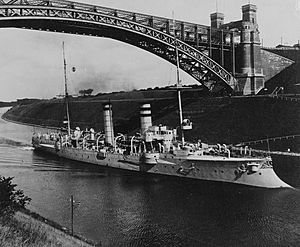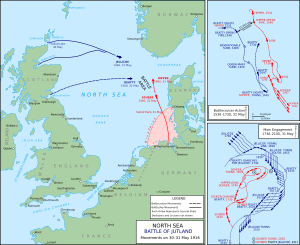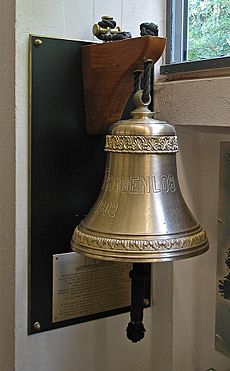SMS Frauenlob facts for kids

Frauenlob passing under the Levensau High Bridge in the Kiel Canal
|
|
Quick facts for kids History |
|
|---|---|
| Name | Frauenlob |
| Laid down | 1901 |
| Launched | 22 March 1902 |
| Commissioned | 17 February 1903 |
| Fate | Sunk during the Battle of Jutland, 31 May 1916 |
| General characteristics | |
| Class and type | Gazelle-class light cruiser |
| Displacement | |
| Length | 105 m (344.5 ft) loa |
| Beam | 12.4 m (40.7 ft) |
| Draft | 4.99 m (16.4 ft) |
| Installed power |
|
| Propulsion |
|
| Speed | 21.5 knots (39.8 km/h; 24.7 mph) |
| Range | 4,400 nmi (8,100 km; 5,100 mi) at 12 kn (22 km/h; 14 mph) |
| Complement |
|
| Armament |
|
| Armor |
|
SMS Frauenlob was a fast warship, a light cruiser, built for the German Imperial Navy. Her name means "praise women" in German. She was one of ten ships in the Gazelle class class. These ships were designed to be quick and strong, able to work with the main fleet or serve far away in German colonies.
Frauenlob was built with ten powerful 10.5 cm guns and could reach a top speed of 21.5 knots (about 40 km/h). She was a slightly improved version of her sister ships, with better armor and more space for coal, allowing her to travel further.
After joining the fleet in 1903, Frauenlob was part of the main German fleet's scouting force. She took part in many training exercises and visited other countries. Her crew even won awards for their excellent shooting skills in 1906 and 1907. In 1908, she was put into reserve, meaning she was kept ready but not actively used.
When World War I started in August 1914, Frauenlob was brought back into service. She fought in the Battle of Heligoland Bight later that month, where she caused serious damage to a British cruiser. For the next two years, she was involved in fleet operations. Her final battle was the Battle of Jutland on May 31, 1916. During a chaotic night fight, she was hit by a torpedo and sank quickly. Most of her crew were lost. Her wreck was found in 2000 and is still in good condition on the seabed.
Contents
Building the Frauenlob
The German Imperial Navy wanted a new type of small warship. They needed a cruiser that was fast, well-armed, and protected, good for both fleet battles and long trips to distant colonies. The Gazelle class was the result, and it became the model for all future German light cruisers.
Frauenlob was one of the last three ships in her class. She was made a bit stronger than the earlier ships. She was about 105 meters (344 feet) long and 12.4 meters (40 feet) wide. Her engines were designed to produce 8,000 horsepower, giving her a top speed of 21.5 knots. She could carry 700 tons of coal, allowing her to travel about 4,400 nautical miles (8,100 km) at a slower speed. Her crew included 14 officers and 256 sailors.
The ship was armed with ten 10.5 cm guns. Two guns were at the front, six in the middle (three on each side), and two at the back. These guns could hit targets up to 12,200 meters (13,300 yards) away. She also had two 45 cm torpedo tubes, which were built into the sides of her hull. For protection, her deck armor was 20 to 25 mm thick. The command center, called the conning tower, had 80 mm thick sides, and the gun shields were 50 mm thick.
Early Years of Service
Frauenlob was built at the AG Weser shipyard in Bremen, Germany, starting in mid-1901. She was launched sideways into the water on March 22, 1902. A vice admiral gave a speech, and Princess Anna Reuss of Köstritz officially named the ship. The name "Frauenlob" means "praise women." This was a tribute to an older ship that women in Germany had helped pay for.
The cruiser began her sea trials on February 17, 1903. After testing, she joined the main German fleet's scouting force in Kiel. She took part in a cruise to Spain in May and June, and then to Norway in July. In September, she went into drydock for repairs. She also joined the fleet for winter training in the North and Baltic Seas.
In 1904, Frauenlob continued with training exercises and cruises. The German fleet visited Britain, the Netherlands, and Norway in July and August. In 1905, she accidentally ran aground (hit the bottom) while leaving Bremerhaven, damaging her rudder. She was later repaired. Her crew won the "Shooting Prize" from Emperor Wilhelm II in 1906 and again in 1907 for their excellent gunnery. In 1908, Frauenlob was taken out of active service and placed in reserve. She stayed there for six years.
World War I Service
Battle of Heligoland Bight
Frauenlob was brought back into service on August 2, 1914, when World War I began. She was assigned to a scouting group. On August 28, the British attacked German patrols in the Helgoland Bight. Frauenlob was anchored nearby, ready to help.
Around 9:00 AM, Frauenlob and another cruiser, Stettin, were sent to support the German patrols. They soon met the British cruiser HMS Arethusa and some destroyers. Frauenlob and Stettin opened fire at 9:09 AM. They hit the British ship many times, damaging most of its guns and causing a fire. Arethusa turned away to escape, but Frauenlob kept firing until the British ship disappeared in the fog. Frauenlob was hit ten times but not badly damaged. Five of her crew were killed, and 32 were wounded. After the battle, Frauenlob helped tow a damaged German minesweeper back to safety.
After repairs, Frauenlob joined the main German fleet for several operations in 1914 and 1915. These included supporting raids on British towns and searching for enemy ships. None of these operations led to major battles. In late 1915, she went into drydock for an overhaul. She returned to service in March 1916.
- {{lang|de|Frauenlob}} at the Battle of Heligoland Bight
-
Actions of Frauenlob in the Battle of Heligoland Bight
Battle of Jutland
In late May 1916, the German fleet commander planned a large operation. He wanted to lure out part of the British fleet and destroy it. The German fleet included many powerful battleships and cruisers. Frauenlob was part of the IV Scouting Group, which was tasked with protecting the main German fleet. The British, however, had intercepted German radio messages. They sent their entire Grand Fleet to stop the Germans.
The battle began on May 31. Frauenlob was not heavily involved in the early parts of the fight. Later that evening, around 9:15 PM, her scouting group briefly met a British cruiser squadron. Due to poor visibility, only a few shots were fired without much effect.
Later, during the confused night fighting, Frauenlob's group accidentally ran into another British cruiser squadron. A fierce battle started at very close range. Frauenlob opened fire on the British cruisers HMS Southampton and HMS Dublin. In return, Southampton launched a torpedo that hit Frauenlob around 10:35 PM. The torpedo strike cut her power and caused severe flooding. British shells also set her deck on fire. The damaged cruiser quickly capsized and sank. Only nine men from her crew survived; they were rescued by a Dutch ship and held in the Netherlands for the rest of the war. Over 300 German sailors died when Frauenlob sank.
The Wreck of Frauenlob
In the year 2000, Danish divers found the wreck of Frauenlob. A British marine archaeologist, Innes McCartney, later led a dive to explore it. He confirmed that the ship sits upright on the seabed and is mostly intact. Sadly, the remains of some of her crew are still scattered around the sunken cruiser. The wreck was positively identified in 2001 when McCartney's team recovered the ship's bell. This bell was then given to the Laboe Naval Memorial near Kiel, Germany, where it is now on display.









